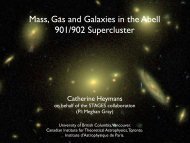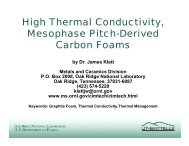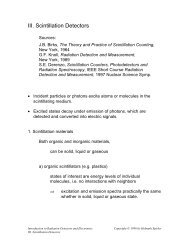Introduction to radiation-resistant semiconductor devices and circuits
Introduction to radiation-resistant semiconductor devices and circuits
Introduction to radiation-resistant semiconductor devices and circuits
You also want an ePaper? Increase the reach of your titles
YUMPU automatically turns print PDFs into web optimized ePapers that Google loves.
The effect of displacement damage on doping characteristics has been<br />
investigated in the course of detec<strong>to</strong>r studies for the SSC <strong>and</strong> LHC <strong>and</strong> is still the<br />
subject of ongoing study. Measurements on a variety of strip detec<strong>to</strong>rs <strong>and</strong> pho<strong>to</strong>diodes<br />
by groups in the U.S., Japan <strong>and</strong> Europe have shown that the effective<br />
doping of n type silicon initially decreases, becomes intrinsic (i.e. very little space<br />
charge) <strong>and</strong> then turns p-like, with the space charge increasing with fluence. This<br />
phenomenon is consistent with the notion that accep<strong>to</strong>r sites are formed by the<br />
ir<strong>radiation</strong>, although this does not mean that mobile holes are created. (13)<br />
Initially, the effective doping level Nd -Na decreases as new accep<strong>to</strong>r states<br />
neutralize original donor states. At some fluence the two balance, creating<br />
“intrinsic” material, <strong>and</strong> beyond this fluence the accep<strong>to</strong>r states dominate. In<br />
addition, there is evidence for a concurrent process of donor removal. (14,15)<br />
Since the probability of donor removal is proportional <strong>to</strong> the initial donor<br />
concentration Nd0, whereas the formation of defects leading <strong>to</strong> accep<strong>to</strong>r states is<br />
proportional <strong>to</strong> fluence, the effective space charge density Neff of n type starting<br />
material after exposure <strong>to</strong> a particle fluence Φ is described by (16)<br />
− cΦ<br />
− t / τ ( T )<br />
Neff ( Φ ) = − Nd 0e<br />
+ gcΦ + gsΦ ⋅ e + NY ( Φ , t, T )<br />
where a negative or positive sign of Neff denotes whether the effective space charge<br />
is n- or p-like. The first term describes the removal of donors <strong>and</strong> the second the<br />
creation of accep<strong>to</strong>rs. c <strong>and</strong> gc are constants for a given particle type <strong>and</strong> energy<br />
that describe the stable component of <strong>radiation</strong> damage. The third <strong>and</strong> fourth terms<br />
describe the time <strong>and</strong> temperature dependent changes in the effective doping concentration<br />
<strong>and</strong> will be discussed later. For high energy pro<strong>to</strong>ns the average from<br />
many measurements is c= (0.96±0.19)⋅10 -13 cm 2 <strong>and</strong> gc = (1.15±0.09)⋅10 -2 cm -1 .<br />
Type inversion from n <strong>to</strong> p type silicon occurs at a fluence of about 10 13 cm -2 . Data<br />
for 1 MeV equivalent neutrons yield c= (2.29±0.63)⋅10 -13 cm 2 <strong>and</strong><br />
gc = (1.77±0.07)⋅10 -2 cm -1 . (9)<br />
After a pro<strong>to</strong>n fluence Φ= 10 14 cm -2 the accep<strong>to</strong>r concentration before annealing<br />
is 10 12 cm -3 , which requires a bias voltage of 165V for full depletion of a 300<br />
μm thick detec<strong>to</strong>r. At first glance, it would seem that beginning with a higher<br />
n doping level Nd0 (lower resistivity) would increase overall detec<strong>to</strong>r lifetime.<br />
Although the inversion fluence increases with larger values of Nd0 , the difference in<br />
doping concentration is negligible at larger fluences since the exponential term<br />
quickly becomes insignificant. (15) For example, as shown in Fig. 3 materials with<br />
initial doping densities of 10 12 cm -3 <strong>and</strong> 10 13 cm -3 lie within 15% at Φ= 5⋅10 13 cm -2 .<br />
Very high resistivity silicon (ρ >10 kΩcm or Nd < 4⋅10 11 cm -3 ) is often highly<br />
compensated, Neff=Nd -Na with Nd ~Na>>Neff , so that minute changes <strong>to</strong> either<br />
donors or accep<strong>to</strong>rs can alter the net doping concentration significantly, <strong>and</strong> the<br />
9<br />
(4)





